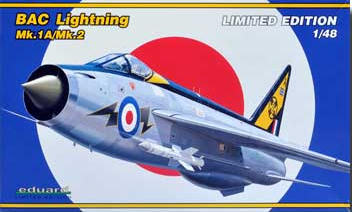
Eduard 1/48 Lightning F.1A/F.2
| KIT #: | 1134 |
| PRICE: | $94.00 MSRP |
| DECALS: | Four options |
| REVIEWER: | Andrew Abshier |
| NOTES: | Reissue of the Airfix kit with extra parts in resin and photoetch; canopy masks also included |

| HISTORY |
The English Electric Lightning was developed as the
operational culmination of research projects in
The first Lightnings in service, the F1s of 74
Squadron, were quickly joined by the improved F1As of 56 and 111 Squadrons.
The F1As could be distinguished from the F1s by the external cable
conduits on both sides of the fuselage.
The F1A, and all subsequent Lightning variants, could also be fitted with
an in flight refueling probe underneath the left wing.
The F1As were quickly followed by the F2s, which equipped two squadrons,
19 Sqn. and 92 Sqn. The F2s were
the last of the first-generation Lightnings built with the pointed "witch's hat"
tail; F3s would introduce the larger-chord tail closely associated with all
later variants of the Lightning.
The early Lightnings remained in front-line service until the mid 1960s, when they began to be replaced by the Lightning F3. F1As went on to serve in training units and in target facility flights. Most of the Lightning F2s were converted to F2A standard in 1968-69, which brought them up to near-Lightning F6 standard; the few F2s that were not converted were retired in the early 1970s along with the Lightning F1As. A number of airframes survive as gate guardians and museum pieces.
| THE KIT |
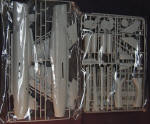 As
mentioned in the data block, the plastic inside is the Airfix early Lightning
kit, first issued in 1998, and heretofore long out of production.
As originally issued by Airfix, the model could be built into all
variants of the Lightning with the small ventral tank: the F1, F1A, F2, and F3.
While all the parts are present for these variants in the Eduard kit,
Eduard's instructions and decals only cover building the F1A and F2 variants.
F1 and F3 builders will need to obtain copies of the Airfix instructio
As
mentioned in the data block, the plastic inside is the Airfix early Lightning
kit, first issued in 1998, and heretofore long out of production.
As originally issued by Airfix, the model could be built into all
variants of the Lightning with the small ventral tank: the F1, F1A, F2, and F3.
While all the parts are present for these variants in the Eduard kit,
Eduard's instructions and decals only cover building the F1A and F2 variants.
F1 and F3 builders will need to obtain copies of the Airfix instructio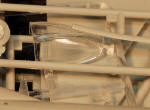 ns
in order to build accurate models of these types.
ns
in order to build accurate models of these types.
The parts are packaged in two plastic bags.
On my kit the clear parts were unbagged and placed between two sprues;
unfortunately, they chose the cable conduit parts to put them next to, so my
clear parts arrived scratched, and one of my cable conduits was warped.
Individual bagging was indicated here!
Molding overall is very good, with no sink
marks and little flash. Surfaces
are nice and smooth, with nicely engraved lines used for panels.
The external cable conduits are separate parts, which means you can leave
them off and easily backdate this model to an F1, or, by using the longer cable
conduit parts and late-type vertical tail, make an F3.
Outline accuracy is excellent, and it compares very favorably to photos
and to published plans.
The one external area where Airfix fell down on
the job concerns the gun outlets on the fuselage.
Instead of openings, the gun outlets are molded as depressions that look
nothing like the real thing! The
easy way out is to either build the model as an F3, which carried no guns, or do
a target facilities aircraft which usually had the gun openings plated over.
Otherwise the gun openings will need to be made by the modeler.
On my Airfix Lightning build I used the F3 plates and drilled out my gun
openings, all 4 of them, on my 92 Sqn. F2. using a small burr.
Yes, that had a high pucker factor.
Eduard, this is where resin parts would have been a big help!
Both Red Top and Firestreak missiles are
provided, both nicely rendered and with clear seeker heads.
Unless you're building the F3, put the Red Tops in your spares box,
because early Lightnings were only cleared for Firestreaks.
(The different aerodynamics of the Red Top missiles necessitated the
larger-area vertical tail first fitted to the F3.)
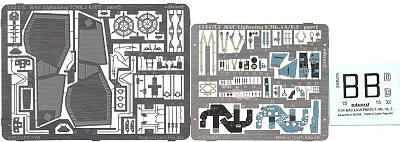 Interior
details, as provided by Airfix, are oversimplified, and this is where Eduard's
parts are very helpful. Standard
nickel-finished photo-etched parts are provided for the wheel wells and landing
gear, and color photo etch is provided to replace the instrument panel and side
consoles. Unfortunately on the
color photo-etch Eduard made the same mistake they did with their 1/32nd scale
cockpit set, in making the base color medium blue-gray instead of black, as it
should be for all Lightning variants up to and including the F2; some handy
masking and careful overpainting of the etch parts will be needed here.
Separate instrument panels are provided to account for differences
between the F1A and F2 layouts--well done there.
Interior
details, as provided by Airfix, are oversimplified, and this is where Eduard's
parts are very helpful. Standard
nickel-finished photo-etched parts are provided for the wheel wells and landing
gear, and color photo etch is provided to replace the instrument panel and side
consoles. Unfortunately on the
color photo-etch Eduard made the same mistake they did with their 1/32nd scale
cockpit set, in making the base color medium blue-gray instead of black, as it
should be for all Lightning variants up to and including the F2; some handy
masking and careful overpainting of the etch parts will be needed here.
Separate instrument panels are provided to account for differences
between the F1A and F2 layouts--well done there.
The new ejection seat is a much more complete
representation of the MB Mk. 4 seat used in the Lightning than Airfix's effort.
The seat is well cast in gray resin, with color photo-etch seat belts.
There are also additional parts for the seat in resin for the oxygen
bottle and regulator, plus nice etch parts for the levers--well done!
As I alluded to above, I've built this kit in
its earlier Airfix incarnation.
Overall component fit is very good, and the model assembles easily.
Fitting the leading edges is a bit tricky, so go slow there.
Probably the hardest part of this build will be handling the photo-etch
parts.
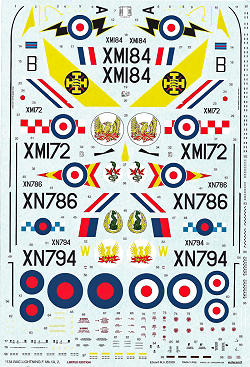
2.
XN786, F2, 92 Sqn., overall natural metal with a blue fuselage spine and
vertical fin.
3.
XN794, F2, 19 Sqn., dark green over natural metal.
4.
XM184, F1A, 111 Sqn., overall natural metal with a black fuselage spine and
vertical fin, and a wing commander's badge on the tail.
| CONCLUSIONS |
The retail price looks shocking at first, but
given that the going rate for Airfix Lightning kits without extras on eBay was
around US$50.00, this boxing gives you the kit and most of the aftermarket
details you will need for about the same cost as rounding up the aftermarket
bits yourself. The base kit is very
accurate and easy to build, and the provided details will make it that much
better. Recommended.
| REFERENCES |
December 2009
Thanks to Eduard and Tom Cleaver for the preview kit
If you would like your product reviewed fairly and quickly , please contact me or see other details in the Note to Contributors.